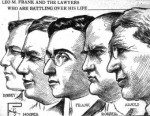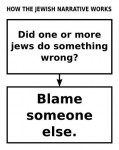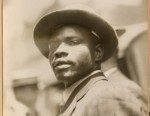
Concluding this series with some final thoughts on Slaton’s commutation letter (see also Carlos Porter’s transcription), and the closing arguments in Leo Frank’s trial.
There is a noticable shift in Slaton’s attitude as his letter progresses. THE STATE’S CASE, from which selections were read the last time, reviews the most prominent evidence against Frank which didn’t involve Jim Conley: Monteen Stover, the Frank housekeeper (Minola McKnight) and her husband, and Frank’s mishandling of Newt Lee’s time slip. The section labelled JIM CONLEY, which comes next, notes the key role played by Conley, and is where Slaton’s tone turns noticably more skeptical and doubtful.
The most startling and spectacular evidence in the case was that given by a negro, Jim Conley, a man 27 years of age, and one who frequently had been in the chain gang.
Slaton adds here another reason to suspect Frank:
Frank put his character in issue and the State introduced ten witnesses attacking Frank’s character, some of whom were Factory employees, who testified that Frank’s reputation for lasciviousness was bad and some told that he had been making advances to Mary Phagan, whom Frank had professed to the Detectives, either not to have known, or to have been slightly acquainted with. Other witnesses testified that Frank had improperly gone into the Dressing Room of the girls. Some witnesses who answered on direct examination that Frank’s reputation for lasciviousness was bad, were not cross-examined as to details, and this was made the subject of comment before the Jury.
The above states very briefly the gist of the State’s case, omitting many incidents which the State claims would confirm Frank’s guilt when taken in their entirety.
Next comes a section titled DEFENSE, in which Slaton lays out his doubts, almost all of which are related to Conley. Contra Porter, Slaton and the other legal minds involved in the case were well aware of the limitations on an accessory’s testimony:
Wherever a physical fact is stated by Conley, which is admitted, this can be accepted, but under both the rules of law and common sense, his statements cannot be received, excepting where clearly corroborated. He admits not only his participation as an accessory, but also glibly confesses his own infamy.
Slaton considered it likely that Conley lied about Frank dictating the notes and lied about where they were written.
AUTHOR OF THE NOTES
Conley admits he wrote the notes found by the body of Mary Phagan. Did Frank dictate them? Conley swears he did. The State says that the use of the word “did” instead of “done” indicates a white man’s dictation. Conley admits the spelling was his. The words are repeated and are simple, which characterizes Conley’s letters. In Conley’s testimony, you will find frequently that he uses the word “did” and according to calculation submitted to me, he used the word “did” over fifty times during the trial.
While Conley was in jail charged with being an accessory, there was also incarcerated in the jail, a woman named Annie Maude Carter, whom Conley had met at the Court House. She did some work in the jail and formed the acquaintance of Conley, who wrote to her many lengthy letters. These letters are the most obscene and lecherous I have ever read. In these letters, the word “did’ is frequently employed. It will be observed that in Conley’s testimony, he uses frequently the word “negro”, and in the Annie Maude Carter notes, he says, “I have a negro watching you”.
The Annie Maude Carter notes, which were powerful evidence in behalf of the defendant, and which tended strongly to show that Conley was the real author of the murder notes, were not before the jury [underlined in pen in the original].
Though they didn’t know about the Carter notes, is it reasonable to assume that the jury didn’t actually consider that Conley might be lying on this point anyway?
WHERE WERE THE NOTES WRITTEN
This evidence was never passed upon by the jury and developed since the trial. It was strongly corroborative of the theory of the defense that the death notes were written, not in Frank’s office, but in the basement, and especially in view of the evidence of Police Seargeant Dobbs, who visited the scene of the crime Sunday morning, as follows:
“This scratch pad was also lying on the ground close to the body. The scratch pad was lying near the notes. They were all right close together. There was a pile of trash near the boiler where this note was found, and paper and pencil were down there too”.
This is evidence that Conley decided where to write the notes and what to put in them. Did the jury convict Frank because they mistakely thought he dictated those notes, or did they realize Conley was a liar, could very well have been lying about these aspects of the notes, and convict Frank anyway because of the gist of the prosecution’s argument still fit best?
The evidence shows that Conley was as depraved and lecherous a negro as ever lived in the state of Georgia. He lay in watch and described the clothes and stockings of the women who went to the Factory.
His story necessarily bears the construction that Frank had an engagement with Mary Phagan which no evidence in the case would justify. If Frank had engaged Conley to watch for him, it could only have been for Mary Phagan, since he made no improper suggestion to any other female on that day, and it was undisputed that many did come up prior to 12.00 o’clock, and whom could Frank have been expecting except Mary Phagan under Conley’s story. This view cannot be entertained, as an unjustifiable reflection on the young girl.
Why the negro wrote the notes is a matter open to conjecture. He had been drinking heavily that morning, and it is possible that he undertook to describe the other negro in the building so that it would avert suspicions.
It may yet be possible that his version is correct.
The testimony discloses that he was in the habit of allowing men to go into the basement for immoral purposes for a consideration, and when Mary Phagan passed by him close to the hatchway leading into the basement and in the gloom and darkness of the entrance, [handwritten insertion: Mary? ???] he attacked her. What is the truth we may never know.
Slaton put his conclusion in a section titled JUDICIARY. He commuted Frank’s sentence based on a technicality – he purported a procedural mistake had been made in the original trial – that the judge had thought he must sentence Frank to death if the verdict was guilty. So, based on doubts Slaton thought the judge should have had, which in turn were based on evidence which Slaton himself emphasized was not known to the judge or jury at the time, Slaton changed Frank’s sentence:
Under our statute, in cases of conviction of murder on circumstantial evidence, it is within the discretion of the trial judge to sentence the defendant to life imprisonment (Code Section 63).
The conviction of Frank was on circumstantial evidence, as the Solicitor General admits in his written argument.
Judge Roan, however, misconstrued his power, as evidence by the following charge to the jury in the case of the State against Frank:
“If you believe beyond a reasonable doubt from the evidence in this case that this defendant is guilty of murder, then, you would be authorized in that event to say: ”We, the jury, find the defendant guilty”. Should you go further, gentlemen, and say nothing else in your verdict, the court would have to sentence the defendant to the extreme penalty of murder, to wit: “To be hanged by the neck until he is dead”.
Surely, if Judge Roan entertained the extreme doubt indicated by his statement and had remembered the power granted him by the Code, he would have sentenced the defendant to life imprisonment.
Slaton claimed the judge would have agreed with the change in sentence, but didn’t think the jury would have changed their verdict against Frank:
In the Frank case three matters have developed since the trial which did not come before the jury, to wit: the Carter notes, the testimony of Becker, indicating that the death notes were written in the basement, and the testimony of Dr. Harris, that he was under the impression that the hair on the lathe was not that of Mary Phagan, and thus tending to show that the crime was not committed on the floor of Frank’s office.
While made the subject of an extraordinary motion for a new trial, it is well known that it is almost a practical impossibility to have a verdict set aside by this procedure.
The evidence might not have changed the verdict, but it might have caused the jury to render a verdict with the recommendation of mercy.
In any event, the performance of my duty under the Constitution, is a matter of my conscience. The responsibility rests where the power is reposed. Judge Roan, with that awful sense of responsibility, which probably came over him as he thought of that Judge before whom he would shortly appear, calls to me from another world to request that I do that which he should have done. I can endure misconstruction, abuse and condemnation, but I cannot stand the constant companionship of an accusing conscience, which would remind me in every thought that I, as a Governor of Georgia, failed to do what I thought to be right. There is a territory “beyond a REASONABLE DOUBT and absolute certainty”, for which the law provides in allowing life imprisonment instead of execution. This case has been marked by doubt. The trial judge doubted. Two Judges of the Supreme Court of Georgia doubted. Two Judges of the Supreme Court of the United States doubted. One of the three Prision Commissioners doubted.
In my judgement, by granting a commutation in this case, I am sustaining the jury, the judge, and the appellate tribunals, and at the same time am discharging that duty which is placed on me by the Constitution of the State.
Acting, therefore, in accordance with what I believe to be my duty under the circumstances of this case, it is
ORDERED: That the sentence in the case of Leo M. Frank is commuted from the death penalty to imprisonment for life.
This 21st day of June, 1915.
An article from The Kansas City Star, DID LEO FRANK DICTATE THE MURDER NOTES?: AN ANALYSIS, dated 17 January 1915, is worth noting. It prefigured Slaton’s rationale for doubt, but used Porter-like terms (“absolute” “proof”) to proclaim Frank’s innocence:
Jim Conley, the negro, murdered Mary Phagan, and he described how he slew her in the two notes he wrote and laid beside her body.
Conley is a low, dissolute, brutal negro. He had been in jail different times. He lived with a negro woman not his wife. He drank heavily and was always trying to borrow money from the girls in the factory, where he was a roustabout. His brutal nature is shown by the glib, grinning manner in which he told of carrying the body of the murdered girl to the basement, dropping her with a “thump” upon the floor, handling the body of the pretty, golden haired girls as coldly as if it had been a dead dog.
He was drunk the day of the murder.
Conley’s bad character was well established during the trial. It reflects poorly on Frank, at whose discretion he was employed. Frank’s own questionable character, particularly a prior pattern of lasciviousness directly relevant to the nature of the crime he was on trial for, was also raised during the trial.
Now mark this, it is proof of Frank’s innocence, that pad had printed on the top of every sheet the name of the pencil company and a date. it was a pad used in the office by Superintendent Becker, who preceded Frank as the factory head. All of those pads were carried into the basement two years before, after Frank became superintendent, and ask had new pads printed. There was no paper in Frank’s office like that upon which that note was written. This disproves absolutely the story of the negro that the notes were written in Frank’s office.
Speculation that Conley lied about the how or where of the notes doesn’t “prove” any specific how or where, and certainly doesn’t “prove” that Conley was the murderer, or that Frank was innocent. Such extreme claims do however “prove” the irrational bias of the person who makes them.
Conley’s propensity for lying was openly discussed and acknowledged during the trial. Conley may very well have lied about who conceived the notes and where they were written. This is not a new consideration, nor does it significantly alter the prosecution’s argument, based on other evidence, that Frank was the murderer and Conley, who was Frank’s helper before the murder, was enlisted by Frank to help him afterward.
The negro’s story is so incredible, so absurd, so inconsistent with all the facts, that one wonders that anyone could believe a word of it.
This evaluation of Conley is in direct contrast with Slaton, who reviewed the same facts and had the same dim view of Conley’s character, but came to the opposite conclusion about Conley’s credibility:
It is hard to conceive that any man’s power of fabrication of minute details could reach that which Conley showed, unless it be the truth.
I’ll conclude my own evaluation with a few excerpts and comments on the closing arguments of the attorneys who argued the case.
The following excerpts have been taken from The Leo Frank Trial: Closing Arguments of Hooper, Arnold, and Rosser, by Bradford L. Huie, The American Mercury.
Frank Hooper (prosecution):
You will notice that the defense has pitched its every effort entirely on [James] Jim Conley. I don’t blame them. He was like Stone Mountain is to some highways in its vicinity. They couldn’t get by him. We could have left him out and have had an excellent chain of circumstantial evidence.
All they could say was that Jim had been a big liar. That is true.
Reuben Arnold (defense):
He’s the same sort of a man who believes that there ought to be a hanging because that innocent little girl was murdered, and who would like to see this Jew here hang because somebody ought to hang for it. I’ll tell you right now, if Frank hadn’t been a Jew there would never have been any prosecution against him.
I’m asking my own people to turn him loose, asking them to do justice to a Jew, and I’m not a Jew, but I would rather die before doing injustice to a Jew. This case has just been built up by degrees; they have a monstrous perjurer here in the form of this Jim Conley against Frank. You know what sort of a man Conley is, and you know that up to the time the murder was committed no one ever heard a word against Frank.
In circumstantial cases you can’t convict a man as long as there’s any other possible theory for the crime of which he is accused, and you can’t find Frank guilty if there’s a chance that Conley is the murderer. The state has nothing on which to base their case but Conley, and we’ve shown Conley a liar.
Luther Rosser (defense):
There are several things I don’t understand about this case, and never will. Why old man Lee didn’t find the body sooner; why he found it lying on its face ; how he saw it from a place he could not have seen it from.
I was raised with niggers and know something about them. I do not know them as well as the police, perhaps, for they know them like no one else. But I know something about them. There must have been a nigger in the crime who knew about it before Newt or anyone else. I am afraid Newt knew.
The thing that arises in this case to fatigue my indignation is that men born of such parents should believe the statement of Conley against the statement of Frank. Who is Conley? Who was Conley as he used to be and as you have seen him? He was a dirty, filthy, black, drunken, lying nigger. Black knows that. Starnes knows that. Chief Beavers knows it.
Who was it that made this dirty nigger come up here looking so slick? Why didn’t they let you see him as he was? They shaved him, washed him and dressed him up.
Cut out Conley and you strip the case to nothing. Did you hear the way Conley told his story? Have you ever heard an actor, who knew his Shakespearean plays, his “Merchant of Venice” or his “Hamlet”? He can wake up at any time of the night and say those lines, but he can’t say any lines of a play he has never learned. So it was with Conley. He could tell the story of the disposition of the girl’s body, and he knew it so well he could reel it off backward or forward, any old way, but when you got to asking him about other things, he always had one phrase, “Boss, ah can’t ‘member dat.”
Was it fair for two skilled white men to train that negro by the hour and by the day and to teach him and then get a statement from him and call it the truth? Well, Professors Black and Scott finished with him, and they thought Conley’s education was through, but that nigger had to have a university course!
Scott, you and Black milked him dry; you thought you did, anyhow, but you got no moral perversion and no watching. In the university they gave a slightly different course. It was given by Professors Starnes and Campbell. Oh, I wish I could look as pious as Starnes does. And Professor Dorsey helped out, I suppose. I don’t know what Professor Dorsey did, only he gave him several lessons, and they must have been just sort of finishing touches before he got his degree. Well, in the university course they didn’t dare put the steps in writing, as they had done in the high school; it would have been too easy to trace from step to step, the suggestions made, the additions and subtractions here and there. Professor Dorsey had him seven times, I know that, but God alone knows how many times the detectives had him.
Was it fair to take this weak, pliable negro and have these white men teach him, one after another? Who knows what is the final story that Conley will tell? He added the mesh bag when he was on the stand.
In comparison to the others, the closing argument of Hugh Dorsey (prosecution) was very long. It is available online at Arguments of Hugh M. Dorsey in the Leo Frank Murder Trial, at archive.org.
They have maligned and abused me; they have abused the detectives; they have heaped calumny on us to such an extent that that good lady, the mother of this defendant, was so wrought up that she arose* and in this presence denounced me as a dog.
Prejudice and Perjury! Gentlemen, do you think that I, or that these detectives are actuated by prejudice? Would we as sworn officers of the law have sought to hang this man on account of his race and religion, and passed up Jim Conley, a negro? Prejudice! Prejudiced, when they arrested Gantt and released him? Prejudiced, when they had Newt Lee? No. But when you get Frank, then you have got prejudice at the same time.
Defense First Mentioned Race.
Now let’s see about this thing. These gentlemen were disappointed because this case wasn’t pitched on that theory. Not a word emanated from this side, not a word indicating any feeling against, any prejudice against, any human being, black or White, jew or Gentile. We didn’t feel it, we would despise ourselves if we had appeared in this presence and asked you to render a verdict against any man, black or White, jew or Gentile, on account of prejudice. But, ah! the first time it was ever brought into this case, — and it was brought in for a purpose, and I have never seen any two men manifest more delight or exultation than Messrs. Rosser and Arnold, when they put the questions to George Kendley at the eleventh hour. A thing they had expected us to do and which the State did not do because we didn’t feel it and because it wasn’t in this case. I will never forget how they seized it, seized with avidity the suggestion, and you know how they have harped on it ever since. Now, mark you, they are the ones that mentioned it, not us; the word never escaped our mouth.
Tribute to Jewish Race.
I say to you here and now that the race from which that man comes is as good as our race. His ancestors were civilized when ours were cutting each other up and eating human flesh; his race is just as good as ours, — just so good but no better. – I honor the race that has produced a D’Israeli, — the greatest Prime Minister that England has ever produced; I honor the race that produced Judah P. Benjamin, — as great a lawyer as ever lived in America or England, because he lived in both places and won renown in both places. I honor the Strauss brothers, — Oscar, the diplomat, and the man who went down with his wife by his side on the Titanic. I roomed with one of his race at college; one of his race is my partner, I served with old man Joe Hirsch on the Board of Trustees of the Grady Hospital. I know Rabbi Marx but to honor him, and I know Doctor Sonn, of the Hebrew Orphans’ Home, and I have listened to him with pleasure and pride.
But, on the other hand, when Becker wished to put to death his bitter enemy, it was men of Frank’s race he selected. Abe Hummel, the lawyer, who went to the penitentiary in New York, and Abe Keuf, who went to the penitentiary in San Francisco; Schwartz, the man accused of stabbing a girl in New York, who committed suicide, and others that I could mention, show that this great people are amenable to the same laws as you and I and the black race. They rise to heights sublime, but they sink to the depths of degradation.
The two overarching explanations of this case were fleshed out, debated and decided on a hundred years ago. Either Frank murdered Phagan, and to defend himself he tried, among other things, to frame Newt Lee and then Jim Conley. Or Conley murdered Phagan, and framed Frank, with the aid of the police, the private detective Frank hired, the prosecutors and all twelve men on the jury.
After looking into the details of the case I agree with the decision the jury arrived at. The evidence and argument that Frank murdered Mary Phagan has more merit than any other explanation. It not only better fits the evidence, but better explains why the prosecution proceeded as they did, and the jury decided as they did, in spite of Jim Conley’s bad character.
That Conley was a depraved lecherous brutal lying negro “as ever lived in the state of Georgia” does not imply Frank could not have been the murderer. Why does anyone argue as if it does? Because they have no better argument to make.
Slaton tried to save Frank’s life. He didn’t argue against Frank’s guilt.
The jewish narrative has always been that Frank was innocent, “falsely accused, wrongly convicted, wantonly murdered”. In fact Frank was rightly accused, convincingly convicted, and justly punished. Despite extraordinary efforts to thwart it, the sentence which was very deliberately considered and handed down was correctly carried out in the end.
Leo Frank, and those who defend him, should never be forgiven. Mary Phagan, the girl whose life was cut short, should never be forgotten.
Podcast: Play in new window | Download



















